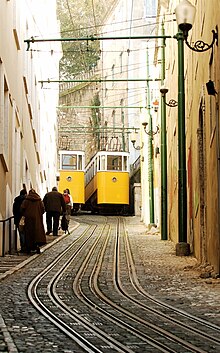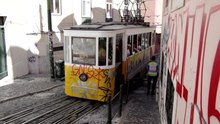Funiculars in Lisbon

The three funiculars in Lisbon , Portuguese Ascensores de Lisboa (translated as lifts from Lisbon ), operate in the Portuguese capital to connect lower parts of the old town with higher parts. Apart from the funicular , they are also technically related to the conventional tram . In contrast to funiculars, their ropes are completely hidden under the road surface. In contrast to a cable tram , the rope connecting the cars with a pulley is always firmly connected to the vehicle. The cars run with classic road wheel sets to be identified in the road space grooved rails, so there is no course Abtschen but only Gleisverschlingungen . The Elevadores do Lavra and da Glória are driven like a tram by means of adhesion via the wheels of the wagons. The rope only serves to balance the masses between the downhill and uphill car, which reduces the energy required for the uphill journey. Normally the downhill trolley exerts traction and pulls the uphill trolley upwards over the rope. Caliper brakes cannot be used because of the covered grooved rails. The safety brakes therefore act on the pull cable channel.
There are the following three trams, all of which - like the city's trams - have a track width of 900 millimeters:
- Ascensor do Lavra - opened in 1884, length 182 m, altitude difference 43 m, max. 25.0% gradient, map
- Ascensor da Glória - opened in 1885, length 265 m, height difference 48 m, max. Incline 18.0%, map
- Ascensor da Bica - opened in 1892, length 260 m, height difference 45 m, max. 19.1% gradient, map
history
The three trams were built in order to be able to develop those parts of the city of Lisbon that could not be served by the horse-drawn tram that started running in 1873 because of the steep gradients. They run through narrow residential streets and were originally powered by water ballast . In the course of the beginning of the replacement of the cable tram, which had been in service since 1890, with electric trams, the funiculars were finally converted to electric drives between 1910 and 1914 . Just like the tram, they are also operated with 600 volts DC voltage . The manufacturer of the trains was the company Ascensores Mecanicos de Lisboa , German mechanical elevators from Lisbon .
The funicular railway is operated by the Carris municipal transport company, as is the case for other urban means of transport such as the tram in Lisbon . Despite their similarity to the tram they are called Ascensor referred (lift) and sometimes in common usage Elevador called, what is a vertically moving elevator (such as the Santa Justa ).
The three tracks are considered to be extremely reliable and have been almost completely spared from accidents for over a century. In recent years, the cars have often been the target of sprayers who damaged the yellow and white paintwork . The railways have been considered national technical monuments for some time.
particularities
At the Ascensores do Lavra and da Gloria, the cars have one drive motor per axle. These are integrated into the chassis of the vehicles in a pawl bearing arrangement and are controlled via the drive switches in the driver's cabs of the two cars. Driving is only possible if both drivers operate the drive switch. On the other hand, each of the two drivers can - if necessary - independently initiate emergency braking , whereupon both vehicles come to a stop at the same time. The motors of both cars are connected in series for driving . For this reason, the funiculars have two-pole overhead lines , with the minus line of the first car being directly connected to the plus line of the second.
The Elevador da Bica, on the other hand, is a classic funicular with a hoisting machine at the mountain station located below street level. The also two-pole catenary only serves to supply the car lighting. As with the other railways, the pull rope runs in a channel under the roadway.
The three funiculars are also supplied by the electricity network of the Lisbon tram. The Ascensor da Glória is fed by the overhead line of line 24E, the Ascensor da Bica by the overhead line of line 28E . In the case of the Ascensor do Lavra , the overhead line of the former line 4 on the short section Torel - Campo Mártires da Pátria was retained as a feed line especially for this purpose, despite the tram service that had been ceased there since 1920 .
The maintenance of the vehicles is not carried out in the main workshop of the tram, but on site in the open air, since the transport of the vehicles to and from the site would be too cumbersome. For major inspections, the car bodies are separated from the bogies and, if necessary, they can be painted on site. The operation of the respective railway will be interrupted for this work.
The Subida à Glória cycling race is held on the track .
Web links
- Daytime Service: Elevators. Info page at the operator Carris (English, Portuguese)
- Elevadores (lifts) - Lisbon. Tram picture book
literature
- Reiner Preuss: funiculars over the Tejo. In: Strassenbahn Magazin , 1/98.
- BR King, JH Price: The Tramways of Portugal. 4th edition, Light Rail Transit Association, London 1995, ISBN 0-948106-19-0 .



